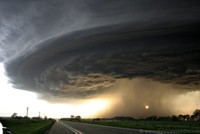Weather disasters increasing from climate change, says UN
 ‘The weather outside is frightful’, according to the
‘The weather outside is frightful’, according to theChristmas song ‘Let it Snow’. Now the United Nations has confirmed
it is so, and we are responsible.
Washington, DC, November 18, 2011 - A
definitive UN science
href=”http://www.ennmagazine.com/12all/lt/t_go.php?i=3078&e=MTU3NTcy&l=-http–ipcc-wg2.gov/SREX/images/uploads/SREX-SPM_Approved-HiRes_opt.pdf”>
report released today confirms the link between climate
change
and extreme weather events, including punishing heat waves,
droughts, and torrential rains and resulting floods.
The report warns that the U.S. will suffer heat waves, droughts,
and more powerful hurricanes like Irene, with vulnerable people and
places likely to suffer most from extreme weather, including
low-lying island States facing sea level rise and stronger storm
surges, and drought-prone countries in Africa.

New York released its own
href=”http://www.ennmagazine.com/12all/lt/t_go.php?i=3078&e=MTU3NTcy&l=-http–nyserda.ny.gov/Publications/Research-and-Development/Environmental/EMEP-Publications/~/media/Files/Publications/Research/Environmental/EMEP/climaid/11-18-response-to-climate-change-in-nys.ashx”
target=”_blank”>climate study this week, predicting that with
expected sea level rise and stronger storms, future hurricanes
could flood the tunnels into Manhattan within an hour and put
one-third of the city underwater, with climate induced impacts
beginning within a decade. The cost of US weather
disasters in 2011 is already approaching $50 billion,
according to the National Climate Data Center.
It is now certain that human emissions of greenhouse gases and
warming aerosols like black carbon are increasing the frequency and
intensity of extreme weather by putting more heat energy into
the
climate system.
“These climate change impacts have become so clear and so close
now that we need fast, aggressive mitigation if we hope to
avoid
the worst consequences,” said Durwood Zaelke, President of the
Institute for Governance & Sustainable Development.

“Fast mitigation is the best adaptation,” Zaelke added.
“Fast mitigation means cutting short-lived climate forcers,
including black carbon, ground-level ozone, and hydrofluorocarbons,
or HFCs, used in refrigeration. Cutting these
non-CO2 climate forcers can be done quickly and
inexpensively using existing technologies and in most cases
existing laws and institutions.”
This can cut the rate of global warming in half for several
decades and the rate of warming in the Arctic by two-thirds,
according to a
href=”http://www.ennmagazine.com/12all/lt/t_go.php?i=3078&e=MTU3NTcy&l=-http–www.unep.org/dewa/Portals/67/pdf/Black_Carbon.pdf”>
report by the UN Environment Program and the World
Meteorological Organization.
Vulnerable island States, along with the U.S., Mexico, and
Canada, are calling on the Montreal Protocol ozone treaty to reduce
HFCs. The parties will be discussing an HFC phase-down next
week at their annual meeting in Bali, Indonesia.
Zaelke stated, “States and cities need to start thinking how
they will pay for adaptation and for cleaning up after extreme
weather events, including following the precedent set by states in
their battle with tobacco companies, which included lawsuits to
recoup health
care costs the states were paying to care for victims of
tobacco
injuries.” The lawsuits resulted in a historic $350 billion
national
tobacco settlement.
Addressing climate change also requires cutting emissions of
CO2, the principal greenhouse gas, protecting and
expanding forests and other “carbon sinks” that remove and store
CO2, and developing other CO2 removal
strategies to draw down excess CO2 from the atmosphere
on a time scale of decades, rather than the millennial time scale
of the natural CO2 removal process.
Source: www.enn.com

